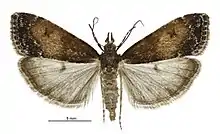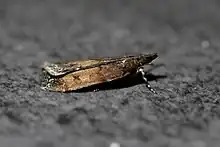Eudonia asterisca
Eudonia asterisca is a moth in the family Crambidae.[3] It was named by Edward Meyrick in 1884 and is endemic to New Zealand. It has been recorded in both the North and South Islands. This species is recorded as being present at sea level up to altitudes of 1350 m. This species has been recorded as inhabiting native podocarp/hardwood forests. The adults of this species are on the wing from December until March although they have also been recorded in October and November. They are attracted to light and have also been trapped via sugar traps.
| Eudonia asterisca | |
|---|---|
 | |
| Female | |
| Scientific classification | |
| Domain: | Eukaryota |
| Kingdom: | Animalia |
| Phylum: | Arthropoda |
| Class: | Insecta |
| Order: | Lepidoptera |
| Family: | Crambidae |
| Genus: | Eudonia |
| Species: | E. asterisca |
| Binomial name | |
| Eudonia asterisca | |
| Synonyms[2] | |
| |
Taxonomy
This species was first described by Edward Myrick in 1884 using specimens collected at Arthur's Pass, Mount Hutt, Lake Wakatipu in January and named Xeroscopa asterisca.[4][5] Meyrick added further described the species in 1885.[5] In 1913 Meyrick placed the species within the genus Scoparia.[6] George Hudson described and illustrated this species in the book The butterflies and moths of New Zealand.[7] In 1988 John S. Dugdale placed this species in the genus Eudonia.[2] The male lectotype, collected at Lake Wakatipu by R. W. Fereday, is held at the Natural History Museum, London.[2]
Description
.jpg.webp)
Meyrick described this species as follows:
Male, female. — 21-23 mm. Head and thorax fuscous, suffused with dark fuscous. Palpi 2+1⁄4, dark fuscous, basal joint white. Antennae fuscous ; ciliations 1⁄2. Abdomen whitish-grey. Legs whitish irrorated with dark fuscous, tibiae and tarsi banded with black. Forewings rather elongate, triangular, costa hardly arched, apex rounded, hindmargin almost straight, rather oblique ; dull ochreous-fuscous, basal and terminal areas suffused with dark greyish-fuscous ; first line, orbicular, and claviform all obsolete, merged in the basal suffusion ; reniforrn x-shaped, suffused, dark fuscous ; second line slender, whitish, dark-margined, moderately curved ; subterminal slender, whitish, not touching second line : cilia whitish, basal third and a posterior line dark greyish-fuscous. Hindwings 1+2⁄5, ochreous-grey-whitish ; lunule distinct, dark grey ; hindmargin narrowly suffused with dark grey ; cilia white, with a dark grey line.[5]
This species is variable in the intensity of ground colour on its forewings as well as the shading at the tips of its hindwings.[7]
Distribution
It is endemic to New Zealand.[1] This species has been recorded in the North and South Islands at elevations from sea level up to approximately 1350 m.[7]
Habitat and hosts
This species is known to inhabit lowland to montane areas.[8] It has also been observed in lowland podocarp/hardwood forest.[9]
Behaviour

Adults are on wing from between December until March but has also been recorded in October and November.[7][10] Adults are attracted to light and have been known to be collected with the use of light as well as sugar traps.[7]
References
- "Eudonia asterisca (Meyrick, 1884)". www.nzor.org.nz. Retrieved 2022-08-02.
- John Stewart Dugdale (23 September 1988). "Lepidoptera - annotated catalogue, and keys to family-group taxa". Fauna of New Zealand. Department of Scientific and Industrial Research. 14: 155. doi:10.7931/J2/FNZ.14. ISSN 0111-5383. Wikidata Q45083134.
- Gordon, Dennis P., ed. (2010). New Zealand inventory of biodiversity: Kingdom animalia : chaetognatha, ecdysozoa, ichnofossils. Vol. 2. p. 458. ISBN 978-1-877257-93-3. OCLC 973607714. OL 25288394M. Wikidata Q45922947.
- Edward Meyrick (1884). "Descriptions of New Zealand Microlepidoptera. IV. Scopariadae". New Zealand Journal of Science. 2: 237. Wikidata Q113372586.
- Edward Meyrick (1885). "Art. XI. — Descriptions of New Zealand Micro-Lepidoptera". Transactions and Proceedings of the New Zealand Institute. 17: 118–119. ISSN 1176-6158. Wikidata Q113379604.
- Edward Meyrick (1913). "A revision of New Zealand Pyralidina". Transactions and Proceedings of the New Zealand Institute. 45: 45. ISSN 1176-6158. Wikidata Q113379622.
- George Vernon Hudson (1928), The butterflies and moths of New Zealand, Illustrator: George Hudson, Wellington, p. 204, LCCN 88133764, OCLC 25449322, Wikidata Q58593286
{{citation}}: CS1 maint: location missing publisher (link) - Brian H. Patrick (1994), Coastal butterflies and moths of Wellington and South Wairarapa. (PDF), Wikidata Q110426707, archived from the original (PDF) on 13 December 2021
- Scott Hooson (2 September 2014). Christchurch District Plan Site of Ecological Significance: Breitmeyers (PDF) (Report). Christchurch City Council. pp. 1–17. Retrieved 2 May 2018.
- Alan Emmerson; Robert Hoare (28 October 2019). "Lepidoptera from Redvale, Albany, north of Auckland, New Zealand, 2004-2016: an annotated list". The Wētā. 53: 43–70. ISSN 0111-7696. Wikidata Q105342215.